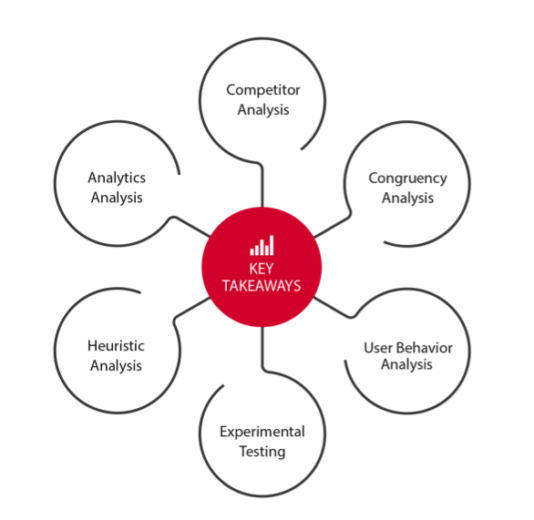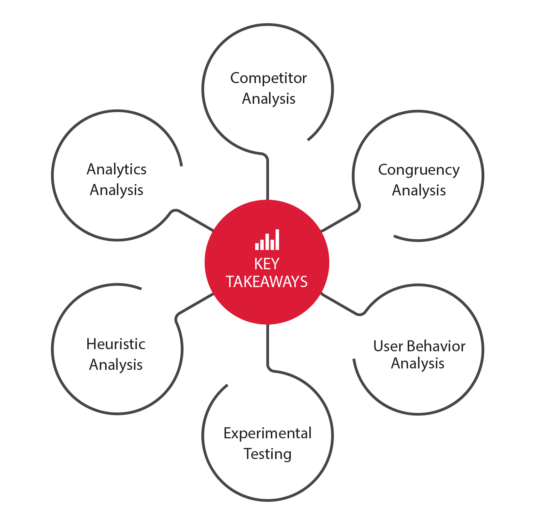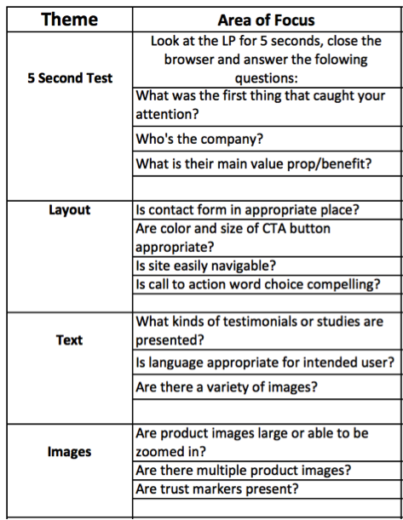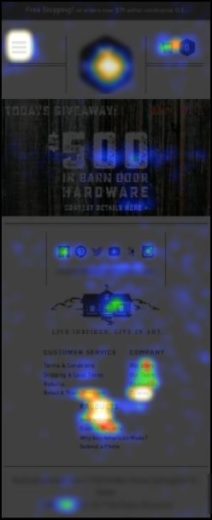6 Components of A Successful CRO Program

Last month we discussed the importance of conversion rate optimization (CRO). Having a CRO program is vital to making the right optimizations for the right users. Today we will dive into what our CRO program looks like at Hanapin Marketing. Our program contains the following:

As you can see from our graphic above, all of these analyses feed into our key takeaways. There is no exact order for these analyses and there is no stopping point. We’re continuously going to be analyzing each of these aspects to feed our key takeaways and our testing recommendations. You may be wondering why these analyses aren’t centered around “Experimental Testing.” With every test we perform, we will gain insights about our users and learn how they perceive the test and interact with the site because of our changes.
Let’s take a brief look into what each of these different analyses entails and how they work together to fuel our key takeaways.
Heuristic Analysis
An internal team of experts will walk through the site or landing pages with an unbiased opinion. The team will be seeing the pages for the first time, they won’t have any data in front of them or any knowledge of how these pages have historically performed. The goal of this analysis is to see what stands out to our team. What problems do we face and what causes us friction? If we have a bad experience or we run into problems on the site, your customers will probably face these challenges too. We develop a list of items that may need addressed and we take this list into account when we continue through our different analyses. Do your customers struggle with the same things our team struggled with or is the site designed appropriately for your users?

These are just a handful of questions we take into consideration when performing our heuristic analysis. As you can see, we take a look at every aspect of the site or landing pages. Our team also looks at lead-generation and e-commerce specific questions depending on the client. These questions are meant to be guidelines so can ensure we’re performing a thorough analysis of the site.
Analytics Analysis
Analytics gives us key information about our users and our site. At this stage we’ll learn who our users are, what devices they’re using and how they’re behaving on the site. Analytics also tells us about the landing pages themselves. Which pages are getting the most traffic, are they being engaged with well or are they causing users to leave the site? Analytics will help guide the CRO program in the right direction – what users should we target, what pages do we need to test, etc.
Competitor Analysis
While we do take into consideration your direct competitors as a company, we won’t always include them in our analysis. In this competitor analysis, our focus is to see who is directly competing with you in the auction. Auction insights will help guide us but to perform this analysis we will take a few of your keywords and perform a Google search. We want to analyze the ads and landing pages of those companies that are appearing right next to you on the search engine results page. How do their ads and landing page experiences compare to ours – what have they done better than us and what are we excelling at? Also important, we want to compare the congruency from search term, to ad, to landing page.
Congruency Analysis
Perfect segue, eh?

One of the reasons it’s important to be working alongside the PPC account is to maintain and increase congruency. We want to ensure congruency exists throughout the user’s entire journey starting with their search term to the ad they click on and the landing page they arrive at. Congruency provides a couple of things to the users: consistency, assurance and met expectations.
Congruency provides consistent language and messaging throughout their entire journey. They’re assured they’re given accurate information in the ads and they’re in the right place. For example, if a user sees black boots for 25% off in the ad but they don’t see the sale on the following landing page, they’re going to assume they’ve been given inaccurate information. These inconsistencies lead users to bounce and purchase from competitors. Congruency also allows for those expectations that are set in the ads to be met on the landing pages. Checkout a previous post of mine for some examples of what you should and shouldn’t do to ensure you’re aligning those user expectations.
User Behavior Analysis
To this point, we’ve learned who our users are, what pages they’re visiting, how our competitors stack up, and how congruent the user’s experience is throughout the entire journey starting with their search. This is our chance to get to know how your users are interacting with the site. With the use of heat maps, user recordings, methods such as the 5-second test and other tools, we’re able to determine where users are focusing their attention, how they’re navigating the site and what’s causing potential friction for them.

Looking at this mobile home page, we’re able to discover a couple insights just from this heat map.
- Look at the hotspot on the logo centered at the top of the page.
- We can assume users believe they’re on a landing page as opposed to a home page. This could be due to the giveaway presented in the hero image or lack of content.
- Check out the hotspots in the footer.
- One of these is centered on the products. Users have come to this site to shop but there is no product information presented to them.
- The other is focused on the story of the company. From this, we assume users want to know about the brand out of curiosity and to gain some credibility
We can use the insights we gain from the user behavior analysis to fuel our optimizations.
Experimental Testing
The goal of experimental testing is to:
- Find the problem
- Develop a hypothesis
- Test the hypothesis
- Come to a conclusion
[bctt tweet=”Having a CRO program is vital to making the right optimizations for the right users.” username=”@samantha__kerr”]
Following our analyses, we’re able to identify a problem. Our goal is to ultimately increase conversion rate while focusing on all relevant metrics of the funnel in order to improve the user experience. To do this, we look for a solution to the problem and develop a hypothesis. To test this we’ll create one of the following tests:
- A/B
- Multivariate
- Split
The last step is the conclusion. There are many variables that go into successfully concluding a test including sample size, run time and statistical significance.
With the conclusion of our test, we’ll either see positive or negative results. We’ll learn more about our users and how they prefer to interact and engage with our site, further fueling our testing cycle.
Final Thoughts
We want to think of these stages as building blocks rather than their own entities. In Google Analytics, we may notice users dropping off at a certain step in the checkout process. Looking at the user recordings, we can determine exactly what is causing those users to drop off and find a solution to push users through the funnel. In this instance, our analytics analysis and our user behavior analysis work together to fuel our key takeaways.
In summary, every stage in our CRO program is vital to creating data-driven optimizations. What does your CRO program look like? Tweet me at @samantha__kerr.



